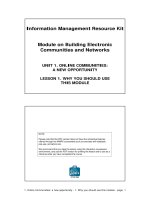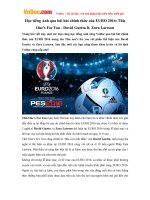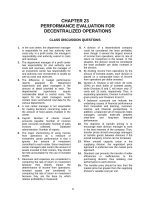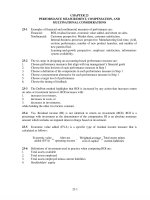macroeconomic mcgrowhill micro ch 23 19e use this one
Bạn đang xem bản rút gọn của tài liệu. Xem và tải ngay bản đầy đủ của tài liệu tại đây (384.55 KB, 34 trang )
Some Key Fa
cts
The Economic
Basis for T
rade
Supply and D
emand Analys
is of Export
s and Import
s
Trade Barrier
Trade Adjust
ment Assista
nce
Last Word
Key Terms
End Show
23-1
23
International
Trade
Copyright 2008 The McGraw-Hill Companies
Chapter Objectives
Some Key Fa
cts
The Economic
Basis for T
rade
Supply and D
emand Analys
is of Export
s and Import
s
Trade Barrier
Trade Adjust
ment Assista
nce
Last Word
Key Terms
End Show
23-2
• The Graphical Model of Comparative
Advantage, Specialization, and the
Gains From Trade
• How Differences Between World Prices
and Domestic Prices Prompt Exports
and Imports
• How Economists Analyze the Economic
Effects of Tariffs and Quotas
• The Rebuttals to the Most Frequently
Presented Arguments for Protectionism
• About the Assistance Provided Workers
Under the Trade Adjustment Act of 2002
• How the Offshoring of U.S. Jobs Relates
to the Growing International Trade in
Services
Copyright 2008 The McGraw-Hill Companies
Some Key Trade Facts
• U.S. trade deficit in goods
• $517 billion in 2009
• U.S. trade surplus in services
• $138 billion in 2009
• Canada largest U.S. trade partner
• Trade deficit with China
• $220 billion in 2009
• Exports are 13% U.S. output
• Dependence on oil
LO1
23-3
Some Key Facts
Some Key Fa
cts
The Economic
Basis for T
rade
Supply and D
emand Analys
is of Export
s and Import
s
Trade Barrier
Trade Adjust
ment Assista
nce
Last Word
Key Terms
• U.S. Sizable Trade Deficit with
China
• U.S. Dependence on Oil is
Reflected
• U.S. has World’s Highest Trading
Volume (Exports and Imports)
• China a Major Trade Force
• International Trade Links World
Economies
• International Trade is the Center
of Policy Debates
End Show
23-4
Copyright 2008 The McGraw-Hill Companies
Some Key Trade Facts
• Principal U.S. exports include:
• Chemicals
• Agricultural products
• Consumer durables
• Semiconductors
• Aircraft
• U.S. provides about 8.5% of world’s exports
LO1
23-5
Some Key Trade Facts
LO1
23-6
Some Key Facts
Some Key Fa
cts
The Economic
Basis for T
rade
Supply and D
emand Analys
is of Export
s and Import
s
Trade Barrier
Trade Adjust
ment Assista
nce
Last Word
Key Terms
Shares of World Exports,
Selected Nations
GLOBAL PERSPECTIVE
Percentage Share of World Exports, 2004
0
Germany
United States
China
Japan
France
Netherlands
Italy
United Kingdom
2
4
6
8
10
10.0
8.9
6.5
6.2
4.9
3.9
3.8
3.8
End Show
Source: World Trade Organization
23-7
Copyright 2008 The McGraw-Hill Companies
12
Some Key Trade Facts
LO1
23-8
Economic Basis for Trade
• Nations have different resource
•
•
•
LO2
endowments
Labor-intensive goods
Land-intensive goods
Capital-intensive goods
23-9
Comparative Advantage
• Assumptions
• Two nations
• Same size labor force
• Constant costs in each country
• Different costs between countries
• U.S. absolute advantage in both
• Opportunity cost ratio
• Slope of the curve
• Wheat sacrificed per ton of Coffee
LO2
23-10
The Economic Basis for Trade
(a) United States
Trade Adjust
ment Assista
nce
Last Word
45
40
40
35
35
30
30
25
25
20
20
15
15
12
10
A
10
5
4
5
Key Terms
0
End Show
5
10
15 18 20
Wheat (Tons)
23-11
(b) Brazil
Coffee (Tons)
Some Key Fa
cts
The Economic
Basis for T
rade
Supply and D
emand Analys
is of Export
s and Import
s
Trade Barrier
Coffee (Tons)
45
Copyright 2008 The McGraw-Hill Companies
25
30
0
B
5
8 10
15
Wheat (Tons)
20
The Economic Basis for Trade
Some Key Fa
cts
The Economic
Basis for T
rade
Supply and D
emand Analys
is of Export
s and Import
s
Trade Barrier
Trade Adjust
ment Assista
nce
Last Word
• Self-Sufficiency Output Mix
• Specializing Based on
Comparative Advantage
– Principle of Comparative
Advantage
• Terms of Trade
– 1W ≡ 1C in the U.S.
– 1W ≡ 2C in Brazil
• Gains from Trade
• Trading Possibility Line
– Improved Options
– Added Output
Key Terms
End Show
23-12
Copyright 2008 The McGraw-Hill Companies
W23.1
Comparative Advantage
• Gains from trade
• Trading possibilities line
• Slope equals terms of trade
• Improved options
• Complete specialization
• More of both goods
• More efficient resource allocation
LO2
23-13
The Economic Basis for Trade
(a) United States
45
40
35
30
Trading
Possibilities Line
C
20
20
A’
15
12
10
A
c
10
B’
5
4
Key Terms
W
5
10
15 18 20
Wheat (Tons)
23-14
Trading
Possibilities Line
15
5
End Show
30
25
25
0
35
Coffee (Tons)
Trade Adjust
ment Assista
nce
Last Word
C’
40
Coffee (Tons)
Some Key Fa
cts
The Economic
Basis for T
rade
Supply and D
emand Analys
is of Export
s and Import
s
Trade Barrier
(b) Brazil
45
Copyright 2008 The McGraw-Hill Companies
25
30
0
B
5
w w’
8 10
15
Wheat (Tons)
20
The Economic Basis for Trade
Some Key Fa
cts
The Economic
Basis for T
rade
Supply and D
emand Analys
is of Export
s and Import
s
Trade Barrier
Trade Adjust
ment Assista
nce
Last Word
• Trade with
Increasing Costs
(curve would be concave,
not linear)
• The Case for Free
Trade
Key Terms
End Show
23-15
Copyright 2008 The McGraw-Hill Companies
Supply and Demand Analysis
of Exports and Imports
Some Key Fa
cts
The Economic
Basis for T
rade
Supply and D
emand Analys
is of Export
s and Import
s
Trade Barrier
Trade Adjust
ment Assista
nce
Last Word
• World Price
• Domestic Price
• Supply and Demand in
the United States
–U.S. Export Supply
• Export Supply Curve
–U.S. Import Demand
Key Terms
• Import Demand Curve
End Show
23-16
Copyright 2008 The McGraw-Hill Companies
Supply and Demand Analysis
of Exports and Imports
(a) U.S. Domestic
Aluminum Market
Surplus = 100
Sd
1.50
1.50
Surplus = 50
1.00
1.00
.75
Shortage = 50
.50
0
50
75
100
125
Quantity of Aluminum
(Millions of Pounds)
End Show
23-17
c
1.25
1.25
Copyright 2008 The McGraw-Hill Companies
b
U.S.
Export
Supply
a
.75
x
U.S.
Import
Demand
.50
y
Dd
Shortage = 100
Key Terms
(b) U.S. Export Supply
and Import Demand
Price (Per Pound; U.S. Dollars
Trade Adjust
ment Assista
nce
Last Word
U.S. Aluminum Market
Price (Per Pound; U.S. Dollars
Some Key Fa
cts
The Economic
Basis for T
rade
Supply and D
emand Analys
is of Export
s and Import
s
Trade Barrier
150
0
50
100
Quantity of Aluminum
(Millions of Pounds)
Supply and Demand Analysis
of Exports and Imports
(a) Canada’s Domestic
Aluminum Market
1.50
1.50
Surplus = 100
Sd
1.25
1.25
Surplus = 50
.75
.50
0
50
75
100
Dd
125
Quantity of Aluminum
(Millions of Pounds)
End Show
23-18
s
1.00
1.00
Shortage = 50
Key Terms
(b) Canada’s Export Supply
and Import Demand
Price (Per Pound; U.S. Dollars
Trade Adjust
ment Assista
nce
Last Word
Canadian Aluminum Market
Price (Per Pound; U.S. Dollars
Some Key Fa
cts
The Economic
Basis for T
rade
Supply and D
emand Analys
is of Export
s and Import
s
Trade Barrier
Copyright 2008 The McGraw-Hill Companies
150
.75
r
a
.50
t
0
Canadian
Export
Supply
50
Canadian
Import
Demand
100
Quantity of Aluminum
(Millions of Pounds)
Supply and Demand Analysis
of Exports and Imports
Trade Adjust
ment Assista
nce
Last Word
World Market for Aluminum
Equilibrium World Price and
Quantity of Exports and Imports
Price (Per Pound; U.S. Dollars
Some Key Fa
cts
The Economic
Basis for T
rade
Supply and D
emand Analys
is of Export
s and Import
s
Trade Barrier
U.S.
Export
Supply
1.00
.88
Canadian
Export
Supply
e
Equilibrium
U.S.
Import
Demand
.75
Canadian
Import Demand
0
Key Terms
50
100
Quantity of Aluminum
(Millions of Pounds)
End Show
23-19
Copyright 2008 The McGraw-Hill Companies
W23.2
•
•
•
•
•
LO4
Trade Barriers and Export
Subsidies
Tariffs
• Revenue tariff
• Protective tariff
Import quota
Nontariff barrier (NTB)
Voluntary export restriction (VER)
Export subsidy
23-20
Economic Impact of Tariffs
• Direct effects
• Decline in consumption
• Increase in domestic production
• Decline in imports
• Tariff revenue
• Indirect effects
LO4
23-21
Economic Impact of Quotas
• Decline in consumption
• Increase in domestic production
• Decline in imports
• Quotas do not provide for any
government revenue but instead
transfer it to foreign producers
LO4
23-22
Trade Barriers
Trade Adjust
ment Assista
nce
Last Word
Sd
Sd + Q
Price
Some Key Fa
cts
The Economic
Basis for T
rade
Supply and D
emand Analys
is of Export
s and Import
s
Trade Barrier
Economic Effects of a Protective
Tariff or an Import Quota
Pd
Pt
Pw
Dd
Key Terms
0
End Show
a
b
Q
c d
Quantity
23-23
Copyright 2008 The McGraw-Hill Companies
Consider Tariff Impact
Some Key Fa
cts
The Economic
Basis for T
rade
Supply and D
emand Analys
is of Export
s and Import
s
Trade Barrier
Trade Adjust
ment Assista
nce
Last Word
Key Terms
• Example of tariff gone awry:
Water Intensive California Rice
(shortage of water and uncertain
future of meeting water needs).
“The U.S. government supports
domestic rice production through
tariffs on imported rice and direct
taxpayer subsidies based on
production, prices, and historical
acreage”..
End Show
23-24
Copyright 2008 The McGraw-Hill Companies
Trade
Barriers
• The Case for Protection: A Critical
Some Key Fa
cts
The Economic
Basis for T
rade
Supply and D
emand Analys
is of Export
s and Import
s
Trade Barrier
Trade Adjust
ment Assista
nce
Last Word
Review
– Military Self-Sufficiency Argument
– Diversification-for-Stability
Argument
– Infant Industry Argument
• Counterarguments
• Strategic Trade Policy
– Protection-Against-Dumping
Argument
• Dumping
– Increased Domestic Employment
Argument
Key Terms
• Smoot-Hawley Tariff Act
End Show
– Cheap Foreign Labor Argument
23-25
Copyright 2008 The McGraw-Hill Companies









